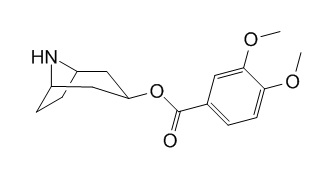Convolvine
Convolvine and its derivatives exhibit pronounced antihypoxic, immunomodulating, and anti-inflammatory activity, they exhibit cytotoxic activity, the alkaloids N-benzylconvolvine and N-chloroacetylconvolvine at concentrations of 10 ug/mL exhibit the greatest activity against HeLa and Hep cancer cell cultures. Convolvine blocks the M-receptors of the heart and intestine but raises the sensitivity of the M-receptors of the salivary gland and of the CNS,convolvine has revealed characteristics of a sedative and nootropic agent.
Inquire / Order:
manager@chemfaces.com
Technical Inquiries:
service@chemfaces.com
Tel:
+86-27-84237783
Fax:
+86-27-84254680
Address:
1 Building, No. 83, CheCheng Rd., Wuhan Economic and Technological Development Zone, Wuhan, Hubei 430056, PRC
Providing storage is as stated on the product vial and the vial is kept tightly sealed, the product can be stored for up to
24 months(2-8C).
Wherever possible, you should prepare and use solutions on the same day. However, if you need to make up stock solutions in advance, we recommend that you store the solution as aliquots in tightly sealed vials at -20C. Generally, these will be useable for up to two weeks. Before use, and prior to opening the vial we recommend that you allow your product to equilibrate to room temperature for at least 1 hour.
Need more advice on solubility, usage and handling? Please email to: service@chemfaces.com
The packaging of the product may have turned upside down during transportation, resulting in the natural compounds adhering to the neck or cap of the vial. take the vial out of its packaging and gently shake to let the compounds fall to the bottom of the vial. for liquid products, centrifuge at 200-500 RPM to gather the liquid at the bottom of the vial. try to avoid loss or contamination during handling.
Journal of Food Quality2022, P:13, 6256310.
Antioxidants (Basel).2020, 9(11):1121.
The University of Manitoba2021, 35690.
Toxicol In Vitro.2023, 93:105667.
Nutrients.2023, 15(6):1335.
Molecules.2020, 25(17):3783.
Horticulture Research2023, uhad164.
Molecules2020, 25(4):892
Korean Herb. Med. Inf.2020, 8(2):233-242.
Front Microbiol.2023, 14:921653.
Related and Featured Products
Chemistry of Natural Compounds,2011,47(4): 608-11.
Derivatives of the alkaloid convolvine and their pharmacological activity[Reference:
WebLink]
METHODS AND RESULTS:
The alkaloid contents of Convolvulus subhirsutus and C. pseudocanthabrica growing in various regions of Uzbekistan, Kazakhstan, and Tadzhikistan were previously investigated and were found to include ~10 tropane alkaloids [ 1 , 2 ]. The alkaloid composition and content depended on the habitat. Thus, total alkaloids in C. subhirsutus growing in Uzbekistan was 0.6–0.75% (aerial part) and 0.6–1.6% (roots) [ 2 , 3 ]; in Tadzhikistan, 0.12%(aerial part) [ 4 ]. The main alkaloids in all plants were nortropine derivatives Convolvine ( 1 , 3,4-dimethoxybenzoyloxynortropane) and Convolamine (3,4-dimethoxybenzoyloxytropane), which amounted to 40–50% of the total. The alkylation and acylation of the NH group in 1 were studied [ 3 ].
CONCLUSIONS:
Preliminary tests showed that the synthesized compounds included some with pronounced antihypoxic, immunomodulating, and anti-inflammatory activity.
Chemistry of Natural Compounds, 2013,48(6):1039-41.
Synthesis of convolinine and cytotoxic activity of alkaloids of the genus Convolvulus and their derivatives[Reference:
WebLink]
The minor base convolinine was synthesized.
METHODS AND RESULTS:
The activity of alkaloids from plants of the genus Convolvulus and their derivatives against HeLa and Hep cancer cell cultures and primary fibroblast culture was studied. It was found that the alkaloid Convolvine and its derivatives exhibited cytotoxic activity.
CONCLUSIONS:
The alkaloids N-benzylConvolvine (4) and N-chloroacetylConvolvine (5) at concentrations of 10 μg/mL exhibited the greatest activity against HeLa and Hep cancer cell cultures. The percent suppression of HeLa cervical carcinoma cells by alkaloid 4 was 35%; of Hep laryngeal cancer cells, 81.6%.
Chemistry of Natural Compounds,1998,34(1):56-8.
Neuro- and psychopharmacological investigation of the alkaloids convolvine and atropine[Reference:
WebLink]
It has been established that Convolvine blocks the M-receptors of the heart and intestine but raises the sensitivity of the M-receptors of the salivary gland and of the CNS, while atropine blocks all the abovementioned M-receptors.
METHODS AND RESULTS:
Convolvine has revealed characteristics of a sedative and nootropic agent. Atropine, however, which is known as a psychomotor stimulator, prevents the realization of a conditioned gastromotor reflex. An analysis has been made of the relationship between features of the pharmacological activities and chemical structures of Convolvine and atropine.



